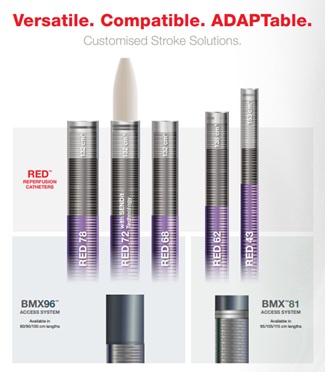This advertorial, intended only for audiences outside the USA, is sponsored by Penumbra.

“Aspiration used to be something straightforward, almost like a ‘no-brainer’, whereas now it is more technical,” says Vincent Costalat (University Hospital of Montpellier, Montpellier, France), speaking shortly after giving a presentation on ‘expanding the options to open the vessel’ at the 2024 European Society of Minimally Invasive Neurological Therapy (ESMINT) congress (4–6 September, Marseille, France). He goes on to state that “we should adapt the ADAPT [direct aspiration] technique” to specific vessel sizes, with the goal of providing a more bespoke solution dependent on the anatomy of the individual acute ischaemic stroke patient being treated.
“I think we are moving from a concept of oversimplification of the aspiration process […] to a concept of aspiration being more optimised, and being tailored to the target vessel,” Costalat tells NeuroNews. “And, when you dive deeper into the science of aspiration—as Penumbra has promoted—it’s interesting to see that you cannot reach the same effect if you do not follow appropriate sizing.”
On this topic, Costalat is not simply speaking from atop an ivory tower; he recalls his own tendency, earlier on in his career, to essentially take the largest-diameter catheter available to him and track it as far as possible into the neurovasculature during mechanical thrombectomy procedures.
“I thought that, the larger the lumen [of the catheter], the more efficient the aspiration of the target clot would be,” he says. “But, when you dive into the physics of it, you understand that this is not the case.”
He goes on to describe recent progress and neurointerventionists’ improved understanding of the science behind aspiration thrombectomy as a “paradigm shift”, leading to a greatly increased focus on more precise catheter sizing as opposed to trying to go as distal as possible with an oversized device.
The relevance of precise sizing
The major technical advantage of appropriate sizing that Costalat highlights is the preservation of blood flow around the outside of the catheter itself during a procedure—a concept that, during benchtop testing, has been shown to boost the efficacy of aspiration.
“This concept of aspiration has to be understood [in terms of how it relates to] ingestion,” he notes. “If you want to bring something very big into the vessel, the diameter of the catheter may be beyond the diameter of the target vessel—then, you are enlarging the vessel yourself with the catheter. And you can still apply force to the thrombus but, after this, you are more prone to get a collapse of the artery because there is no flow surrounding the catheter. You vacuum the rest of the blood, squeezing the vessel.”
In Costalat’s view, this raises a tricky question, because an oversizing approach “may work, but may also harm”.
“We have all had cases where we oversized and got some dissection of the vessel,” he adds. “However, when you are just below the diameter of the target vessel—in terms of the OD [outer diameter] of your catheter—you allow systolic flow to surround the device, and this helps to push the thrombus inside the catheter because you increase the gradient of pressure between the outside of the catheter and the inside of the catheter, in addition to the arterial pressure.
“Secondly, [with the undersizing approach], if you have not ingested the whole thrombus in one attempt, but you still have a pressure gradient, then you can still pull in distant clots [or emboli] that were not initially captured by the catheter because the aspiration is still happening. But, if you are blocking the vessel [with oversizing] after the first part of the thrombus being ingested, then you cannot vacuum anything else because there is no reverse flow induced by the technique.”
Another key area within which Costalat sees promise—beyond the present discussion of catheter sizing—pertains to what he dubs “the intelligence of aspiration”, as enhanced control of the aspiration itself could represent an additional avenue to improving the efficacy of thrombectomy procedures. Penumbra’s investigational computer-assisted vacuum thrombectomy (CAVT) technology is currently being evaluated within the US THUNDER study, and Costalat comments that he and his colleagues will be “very attentive” to its results.
Extended portfolio, extended value
With the company having worked to expand and improve its offering to European neurointerventionists over the past few months, physicians across the continent now have access to a total of five Penumbra catheters intended for use in aspiration thrombectomy: the RED 43, RED 62, RED 68, RED 72 with SENDit technology and RED 78 reperfusion catheters. These devices are compatible with the latest advancements in neurovascular access with the company’s stainless steel hypotube technology—BMX81 and BMX96.
“When you see the different sizes of the vessels in the brain, the margins in between them are quite small,” Costalat explains. “It’s not 3mm or 4mm of difference, it’s more like 0.5mm or maybe 1mm. So, if we want to promote the level of technicity and this concept of preserving flow around the catheter to get the maximum benefit of aspiration, then you need to size before selecting the catheter. We used to have two sizes and now we have five sizes, so the extension of the portfolio allows us to think differently about aspiration.”
 Having a broader range of catheter sizes available, according to Costalat, allows operators to be “more precise and more efficient” when it comes to aspiration thrombectomy—and means they are less likely to have to compromise on device selection.
Having a broader range of catheter sizes available, according to Costalat, allows operators to be “more precise and more efficient” when it comes to aspiration thrombectomy—and means they are less likely to have to compromise on device selection.
“Penumbra extending its portfolio is extending the capability for us to reproduce the concept of ‘full aspiration’, with a good safety level,” he adds.
“The compatibility is just essential,” Costalat continues, alluding to the fact that all of Penumbra’s RED and BMX devices are designed to work harmoniously and interchangeably alongside one another. “It means that you can use one catheter and, if you find that the size was not really appropriate, you can bring a larger-diameter device over the first one and complete the treatment—or, conversely, if you use a bigger size during the first pass and then there is a distal migration, you can complete the treatment without changing anything other than adding a longer catheter to reach the distality.”
When asked to reflect on the slogan accompanying Penumbra’s portfolio of ischaemic stroke products in Europe—which is, ‘Versatile. Compatible. ADAPTable’—Costalat comments that he would describe the company’s current offering as “a fully comprehensive solution for all occlusion types and sizes, and for all situations”.
Delivering a concluding message on this topic, Costalat reiterates that the benchtop studies indicating potential benefits with more precise catheter sizing are “extremely exciting”, adding that he anticipates more extensive evaluations prospectively evaluating the safety and clinical impact of the approach in the near future.
Many of the insights Costalat provides here tie in closely with the notion of Science-Based Aspiration Thrombectomy (S-BAT), which was also recently discussed in detail by Ian Kaminsky (Radiology Imaging Associates, Denver, USA) and Penumbra engineer emeritus Dave Barry for the 2024 SLICE symposium (8–9 November, virtual).
For additional information on this, visit Penumbra’s S-BAT webpage: https://www.penumbrainc.com/science-based-aspiration-thrombectomy-center.
Vincent Costalat is a professor and head of the Department of Neuroradiology at the University Hospital of Montpellier in Montpellier, France, and course director for the SLICE symposium.









